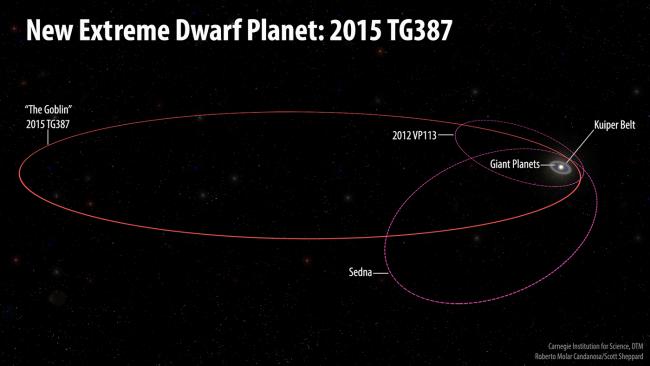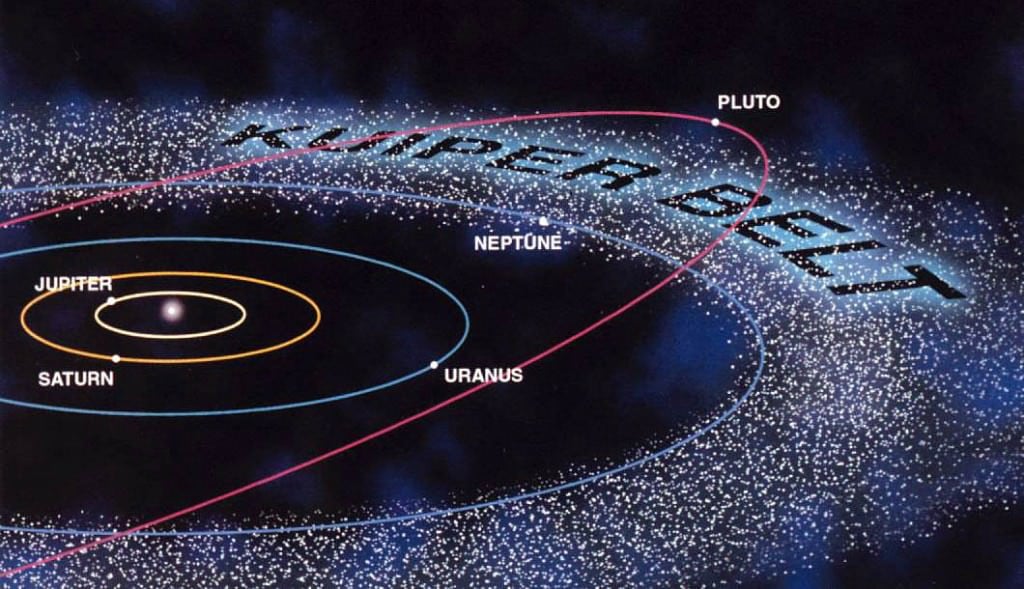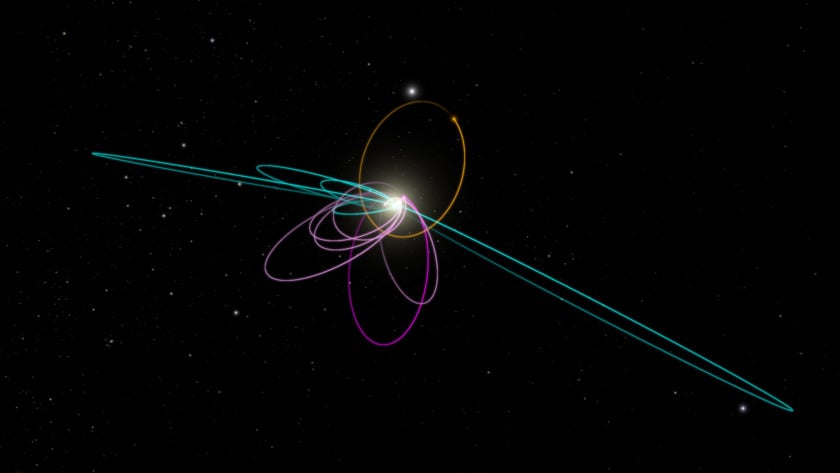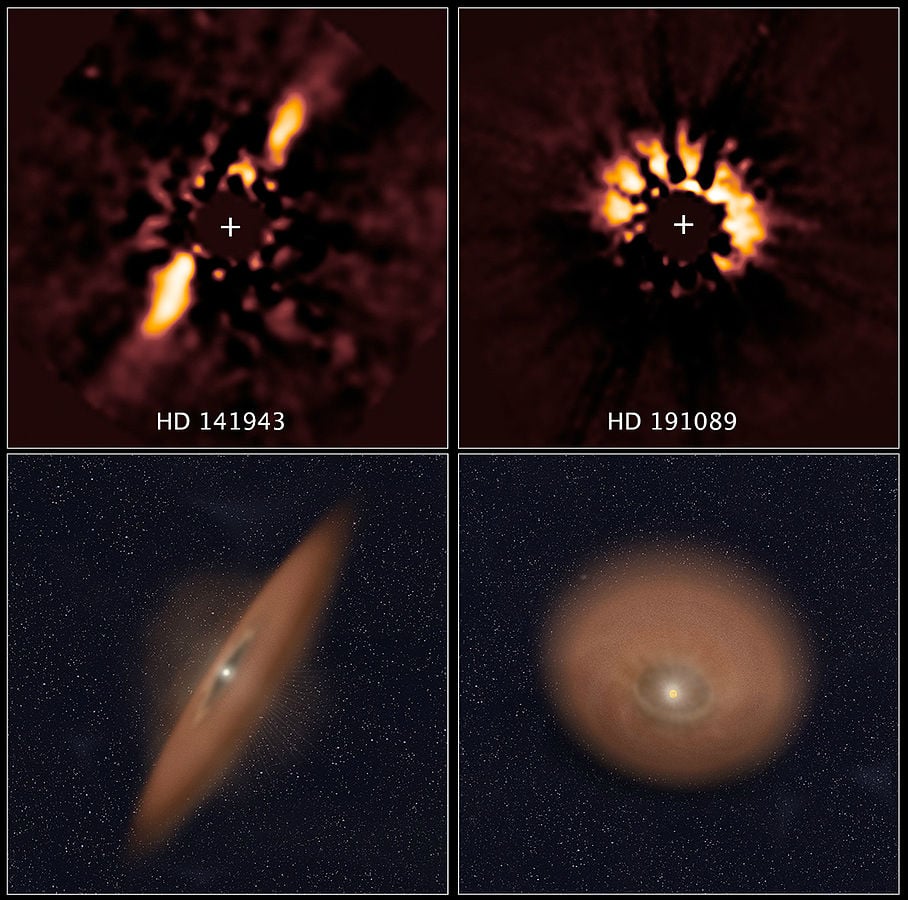Is there or isn't there a Planet 9? Is there a planet way out on the outskirts of our Solar System, with sufficient mass to explain the movements of distant objects? Or is a disc of icy material responsible? There's no direct evidence yet of an actual Planet 9, but something with sufficient mass is affecting the orbits of distant Solar System objects.
A new study suggests that a disc of icy material causes the strange movements of outer Solar System objects, and that we don't need to invent another planet to explain those movements. The study comes from
Professor Jihad Touma, from the American University of Beirut, and
Antranik Sefilian, a PhD student in Cambridge's Department of Applied Mathematics and Theoretical Physics. Their results are published in the Astronomical Journal.
The idea of another planet out there in the furthest reaches of our Solar System is an attractive one. It energizes the adventurer in all of us. And for the astronomer or astronomers who may finally discover it, it would be a crowning achievement. Who wouldn't want to be known as the discoverer of an entirely new planet, right here in our own Solar System? It's much more exciting than being the person who finally confirmed the mass of a disc of icy material.
As astronomers have gotten better at studying and understanding the distant Solar System, they've found more and more objects. In the last 15 years or so, astronomers have discovered about 30 Trans-Neptunal Objects (TNOs) that travel highly-elliptical orbits. The most recent one was "The Goblin," a body with an orbit that takes it as far as 2300 AUs from the Sun.
Since these bodies don't interact gravitationally with the other planets in the Solar System, there must some other aggregate of mass out there that shapes their orbits. And while the Planet 9 explanation has gained steam over the years, there's no direct evidence that a planet is responsible for shaping these strange orbits.
"The Planet Nine hypothesis is a fascinating one, but if the hypothesised ninth planet exists, it has so far avoided detection."
The new study proposes that a disc of icy material is responsible for the highly-elliptical orbits of distant objects. It's not the first theory to suggest this, but it's the first one that can explain the observed orbits, while at the same time accounting for the mass and gravity of the other eight planets in our solar system.
The 30 TNOs that travel these highly-elliptical orbits are part of a larger group of TNOs and objects that make up the Kuiper Belt. The Kuiper Belt is made up of material left over from the formation of the Solar System. Most of these objects travel nearly-circular paths around the Sun. But the 30 that don't travel nearly-circular orbits share a different spatial orientation, and that requires an explanation.
The most-talked about explanation is Planet Nine. Planet Nine would have to be about 10 times more massive than Earth. This planet, hidden out there in the dim reaches of the Solar System, would shepherd these 30 bodies into their unusual orbits.
The problem is, nobody has detected it Planet Nine yet, and it's known only by observed effect.
"The Planet Nine hypothesis is a fascinating one, but if the hypothesised ninth planet exists, it has so far avoided detection," said co-author Antranik Sefilian, a PhD student in Cambridge's Department of Applied Mathematics and Theoretical Physics. "We wanted to see whether there could be another, less dramatic and perhaps more natural, cause for the unusual orbits we see in some TNOs. We thought, rather than allowing for a ninth planet, and then worry about its formation and unusual orbit, why not simply account for the gravity of small objects constituting a disc beyond the orbit of Neptune and see what it does for us?"
The new study is based on detailed modelling of the Solar System, and also on observations of other solar systems.
Touma and Sefilian modelled the full spatial dynamics of TNOs with the combined action of the giant outer planets and a massive, extended disc of material beyond Neptune. They calculated a model that can explain the highly-elliptical, spatially-clustered orbits of the 30 TNOs. They also identified mass ranges and shapes for the icy disc of material. Further, they were able to force gradual shifts in its orientations (or precession rate), which faithfully reproduced the outlier TNO orbits.
"If you remove planet nine from the model and instead allow for lots of small objects scattered across a wide area, collective attractions between those objects could just as easily account for the eccentric orbits we see in some TNOs," said Sefilian, who is a Gates Cambridge Scholar and a member of Darwin College.
So, case closed? Not quite.
"While we don't have direct observational evidence for the disc, neither do we have it for Planet Nine, which is why we're investigating other possibilities."
It's sort of easy to propose another undiscovered planet of just the right mass to explain these observed orbits. But so far, such a planet has avoided detection. But in a way, the disc of icy material theory suffers from the same thing. It's easy enough to propose it, and building a successful mathematical model that supports the icy disk theory at least proves it's possible, but it hasn't been detected yet.
In fact, earlier attempts to estimate the mass of icy objects beyond Neptune have only added up to about one-tenth the mass of Earth, not nearly enough to explain this strange cluster of orbits. The model created by the two scientists behind this new study requires ten times more mass than that.
This is where the observation of other solar systems comes into play.
"The problem is when you're observing the disc from inside the system, it's almost impossible to see the whole thing at once."
"When observing other systems, we often study the disc surrounding the host star to infer the properties of any planets in orbit around it," said Sefilian. "The problem is when you're observing the disc from inside the system, it's almost impossible to see the whole thing at once. While we don't have direct observational evidence for the disc, neither do we have it for Planet Nine, which is why we're investigating other possibilities. Nevertheless, it is interesting to note that observations of Kuiper belt analogues around other stars, as well as planet formation models, reveal massive remnant populations of debris."
Other solar systems have a disc of icy material left over from their formation, with sufficient mass to account for the highly-elliptical orbits of objects on the edge of the systems. Could the same be true in our Solar System? Could there be both a disc of icy material, and a Planet 9?
Sefilian thinks so. "It's also possible that both things could be true – there could be a massive disc and a ninth planet. With the discovery of each new TNO, we gather more evidence that might help explain their behaviour."
The back-and-forth of scientists striving to uncover evidence, sometimes concurring, and sometimes disagreeing vehemently, is on display in this issue.
The study, especially the introduction and conclusion, presents and cites other studies that both support and disagree with this one. We're still in the early days of understanding the distant Solar System in any great detail. With more powerful telescopes coming online over the next few years, and with more powerful computers and improved observation methods, it's only a matter of time before the strange orbits of these distant bodies is finally explained.
Sources:
- Research paper: SHEPHERDING IN A SELF-GRAVITATING DISK OF TRANS-NEPTUNIAN OBJECTS
- Press Release: Mystery orbits in outermost reaches of solar system not caused by ‘Planet Nine’, say researchers
- Universe Today article: New Dwarf Planet Found in the Outskirts of the Solar System, Giving Astronomers More Ammunition to Search for Evidence of Planet 9
- Caltech Press Release: Caltech Researchers Find Evidence of a Real Ninth Planet
- Research paper: EVIDENCE FOR A DISTANT GIANT PLANET IN THE SOLAR SYSTEM
 Universe Today
Universe Today




